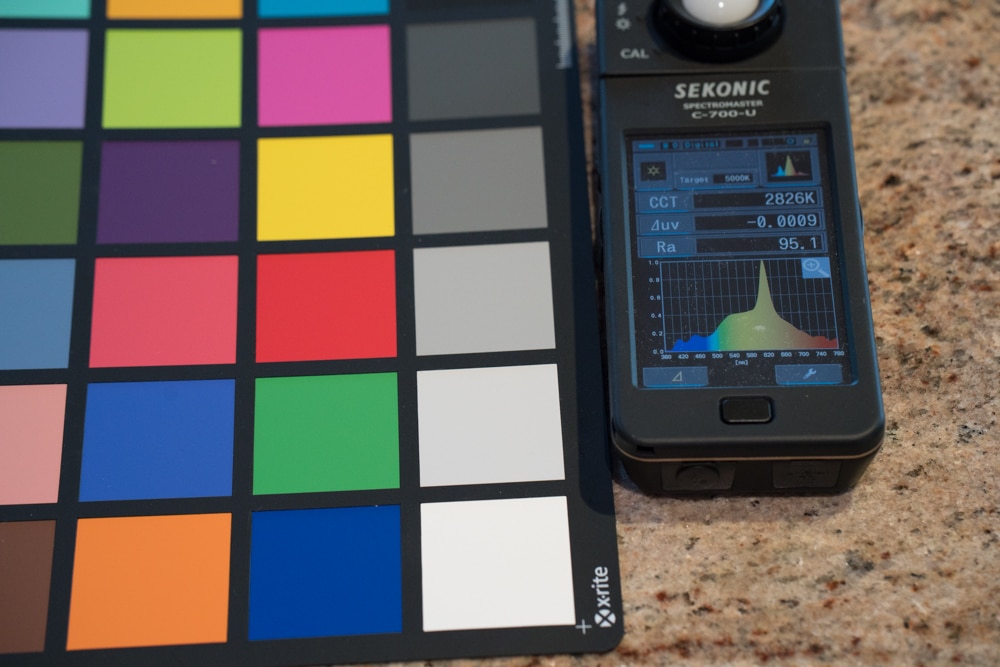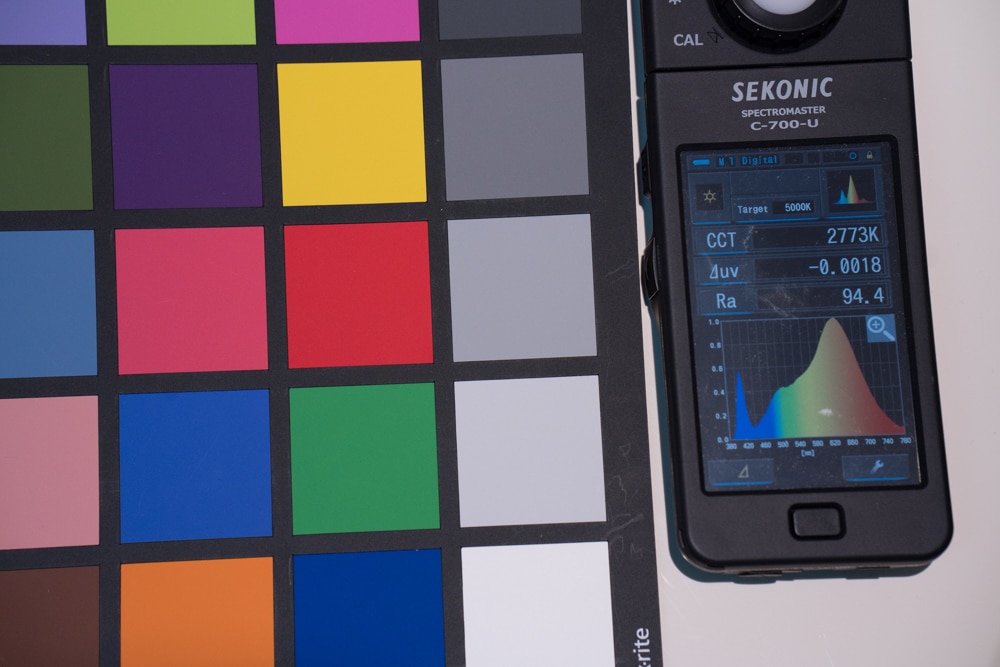I had cataract surgery a few months ago. At the time, I reported on the effects of the surgery on my color vision. Saturday night, a photographer friend came for dinner. At one point, I showed him the new high-CRI LED light that I was planning to swap in for some 6-year-old high CRI (at least, high by the standards of six years ago) LED lights. Both lights were rated at 2700 degrees Kelvin. I said that I thought the new ones had more magenta/red in them than the old ones, and look less yellow. My friend thought they looked greener. Since green and magenta are opposite hues, that was a surprise to me. My friend’s sense of color is highly trained from years as a working photographer, so I didn’t take his opinion lightly. However, I did remember my experience with magenta casts after the surgery, so this morning I pulled out my spectrophotometer and tried to figure out what was going on.
Here’s the old LED:

Ignore the Macbeth patches for now and just look at the spectrum.
There is quite a big peak in the yellow. The meter puts the color temperature at a bit over 2800K, which is pretty close to the rated 2700K. The deviation from the blackbody arc (the triangle followed by uv) is small and is in the magenta direction (plus is above the blackbody arc, and minus is below it).
Here’s the new LED, the one that looked yellow/magenta to me and yellow/green to my friend.

The color temperature is bluer, at a bit under 2800K. The deviation from the blackbody arc in the magenta direction is larger but is still small. The yellow peak is nowhere near as spiky as in the old LED. But there’s a big short-wavelength spike. The wavelength is short enough that it’s in the range that was nearly invisible to me pre-surgery, and that now appears to me as violet. I’m guessing that pre-surgery, I’d have thought the new light was greener, too.
Now you can look at the Macbeth patches. I used a Sony a7RIII for both shots, color balanced to the middle gray square for the top shot, and used that color balance for the bottom one. The top grays appear and measure yellower than the bottom grays.
If we look at the Lightroom white balance, we see that if we balance to the old LED, we get 2900K with a tint of +3, which is slightly magenta. If we do the same with the new LED, the numbers are 2950 (bluer), and -11 (greener). So my friend’s eyes see more like the camera’s sensor than my eyes do. The spectro sees the new LED as very slightly more magenta than the old one. The difference is so small that I’m beginning to suspect that post-surgery, I have greater than normal blue sensitivity. Or, this could just be another surfacing of the long-held belief of many color scientists that the 1931 2-degree Standard Observer is blue-deficient.
Jim, what do +3 and -11 refer to in absolute units? What does Raw Therapee say?
I don’t know.
Good question. Haven’t tried it. Working on AF Adjustment for the 70-200/2.8E.
This is a very interesting topic! A series of comments, starting by the simplest:
* As seen on the Sekonik spectral power distribution display, it is clear most LED lighting systems, even with a high CRI are missing red light contribution, compared to a plain tungsten 3000 k light (see https://www.energie-environnement.ch/images/eclairage/lampes/spectre-halogene.jpg).
* This is due to the fact the CRI calculation Ra does rely only on 8 colour patches, mostly unsaturated. If you need to get a Red patch fidelity info, you need to look at the R9 value, not taken into account in the Ra calculation, but intergrated in the extender CRI index Re, with 6 other colour patches.
* Or even better, use the newly introduced IES TM30 index (see https://www.bridgelux.com/blog/tm-30-15-new-method-measuring-color-rendition) new standard that makes use of 99 reference colors distributed over the entire color space. As a result, it makes use of significantly more colors and hues for the calculation of fidelity index Rf, which describes the same relationship as color rendering index Ra. Gamut index Rg provides information concerning color saturation and color shift, and is similar to gamut area index GAI used previously for the examination of color rendering. Detailed fidelity indexes are available for “bins”of colours, and colour shifts can be displayed for each “bin”.